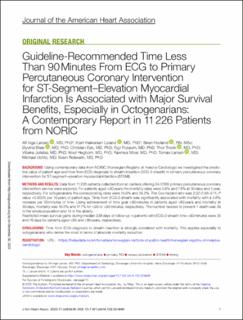| dc.contributor.author | Larsen, Alf Inge | |
| dc.contributor.author | Løland, Kjetil Halvorsen | |
| dc.contributor.author | Hovland, Siren | |
| dc.contributor.author | Bleie, Øyvind | |
| dc.contributor.author | Eek, Christian | |
| dc.contributor.author | Fossum, Eigil | |
| dc.contributor.author | Trovik, Thor | |
| dc.contributor.author | Juliebø, Vibeke | |
| dc.contributor.author | Hegbom, Knut | |
| dc.contributor.author | Moer, Rasmus | |
| dc.contributor.author | Larsen, Tomas | |
| dc.contributor.author | Uchto, Michael | |
| dc.contributor.author | Rotevatn, Svein | |
| dc.date.accessioned | 2023-01-02T10:46:08Z | |
| dc.date.available | 2023-01-02T10:46:08Z | |
| dc.date.created | 2022-10-06T11:22:25Z | |
| dc.date.issued | 2022 | |
| dc.identifier.issn | 2047-9980 | |
| dc.identifier.uri | https://hdl.handle.net/11250/3040264 | |
| dc.description.abstract | Background
Using contemporary data from NORIC (Norwegian Registry of Invasive Cardiology) we investigated the predictive value of patient age and time from ECG diagnosis to sheath insertion (ECG‐2‐sheath) in primary percutaneous coronary intervention for ST‐segment–elevation myocardial infarction (STEMI).
Methods and Results
Data from 11 226 patients collected from all centers offering 24/7/365 primary percutaneous coronary intervention service were explored. For patients aged <80 years the mortality rates were 5.6% and 7.6% at 30 days and 1 year, respectively. For octogenarians the corresponding rates were 15.0% and 24.2%. The Cox hazard ratio was 2.02 (1.93–2.11, P value <0.0001) per 10 years of patient age. Time from ECG‐2‐sheath was significantly associated with mortality with a 3.6% increase per 30 minutes of time. Using achievement of time goal <90 minutes in patients aged >80 years and mortality at 30 days, mortality was 10.5% and 17.7% for <90 or ≥90 minutes, respectively. The number needed to prevent 1 death was 39 in the whole population and 14 in the elderly.
Restricted mean survival gains during median 938 days of follow‐up in patients with ECG‐2‐sheath time <90 minutes were 24 and 76 days for patients aged <80 and ≥80 years, respectively.
Conclusions
Time from ECG‐diagnosis to sheath insertion is strongly correlated with mortality. This applies especially to octogenarians who derive the most in terms of absolute mortality reduction. | en_US |
| dc.language.iso | eng | en_US |
| dc.publisher | Wiley | en_US |
| dc.rights | Attribution-NonCommercial-NoDerivatives 4.0 Internasjonal | * |
| dc.rights.uri | http://creativecommons.org/licenses/by-nc-nd/4.0/deed.no | * |
| dc.title | Guideline-Recommended Time Less Than 90 Minutes From ECG to Primary Percutaneous Coronary Intervention for ST-Segment–Elevation Myocardial Infarction Is Associated with Major Survival Benefits, Especially in Octogenarians: A Contemporary Report in 11 226 Patients from NORIC | en_US |
| dc.type | Journal article | en_US |
| dc.type | Peer reviewed | en_US |
| dc.description.version | publishedVersion | en_US |
| dc.rights.holder | Copyright 2022 The Author(s) | en_US |
| dc.source.articlenumber | e024849 | en_US |
| cristin.ispublished | true | |
| cristin.fulltext | original | |
| cristin.qualitycode | 1 | |
| dc.identifier.doi | 10.1161/JAHA.122.024849 | |
| dc.identifier.cristin | 2059098 | |
| dc.source.journal | Journal of the American Heart Association (JAHA) | en_US |
| dc.identifier.citation | Journal of the American Heart Association (JAHA). 2022, 11 (17), e024849. | en_US |
| dc.source.volume | 11 | en_US |
| dc.source.issue | 17 | en_US |

